اماکن تاریخی هیرائی زومی
معابد و اماکن تاریخی هیرائی زومی مجموعهای از ۵ مکان مربوط به قرن یازده و اوایل قرن دوازدهم در هیرائی زومی، استان ایواته در ژاپن هستند . این اماکن در سال ۲۰۱۱، تحت ضوابط ii ، iii ، iv و vi، در فهرست میراث جهانی ثبت شدند.[1] برای چهار نسل از ۱۰۸۷، زمانی که فوجیوارا نو کیوهیرا قرارگاه و محل اقامت خود را از شمال منتقل کرد تا ۱۱۸۹ زمانی که ارتش میناموتونو یوریتومو به فوجیوارای شمالی پایان دادند، هیرائی زومی به عنوان مرکز مهم سیاسی، نظامی، تجاری و فرهنگی شناخته میشود. .[2][3]
| معابد و اماکن تاریخی هیرائی زومی | |
|---|---|
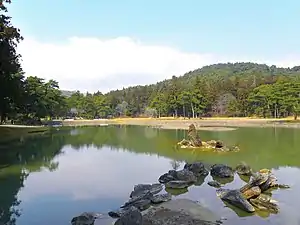 | |
| اطلاعات اثر | |
| مکان | |
| نوع | فرهنگی |
| معیار ثبت | ii, vi |
| شمارهٔ ثبت | ۱۲۷۷ |
| منطقه | آسیا-اقیانوس آرام |
| تاریخچه | |
| تاریخچهٔ ثبت | ۲۰۱۱ (طی نشست نامشخص) |
| † منطقهٔ بر پایهٔ دستهبندی یونسکو | |
آثار تاریخی
| نام | نوع | توضیحات | نگاره |
|---|---|---|---|
| Chūson-ji (中尊寺)[4][5][6] | Temple | Said to have been founded by Ennin in ۸۵۰; rebuilt by Fujiwara no Kiyohira at the beginning of the twelfth century with a pagoda and the Daichōju-in, a Great Hall dedicated to Amida; fires in 1337 consumed many buildings and temple treasures; unusually, the mummified bodies of Fujiwara no Kiyohira and his heirs were interred at the Konjikidō, the Hall of Gold dedicated to Amida (pictured; National Treasure); the compound is a Special Historic Site | 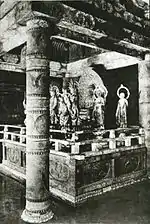 |
| Mōtsū-ji (毛越寺)[7][8][9][10] | Temple | Said to have been founded by Ennin in ۸۵۰; rebuilt by Fujiwara no Motohira in the twelfth century; its destruction by fire in 1226 was lamented in Azuma Kagami as the loss of a monument 'incomparable in our time'; the tweflth-century paradise garden, with stone-paved stream, pond, pebble beach, peninsula, island, and ornamental stones is a Special Place of Scenic Beauty; the site of an associated معبد شینتویی is a Special Historic Site | 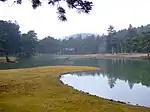 |
| Site of Kanjizaiō-in (観自在王院跡)[9][11][12] | Temple | Founded adjacent to Mōtsū-ji with two Amida Halls by the wife of Fujiwara no Motohira in the twelfth century; destroyed by fire in ۱۵۷۳; twelfth-century paradise garden with stream, pond, pebble beach, island, and waterfall stone arrangement; a Special Historic Site | 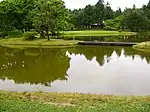 |
| Site of Muryōkō-in (無量光院跡)[9][13][14][15] | Temple | Founded with a monumental statue of Amida by Fujiwara no Hidehira in the twelfth-century; modelled on بیودواین near Kyoto; twelfth-century paradise garden with pond, island and ornamental stones; a Special Historic Site | 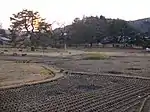 |
| Kinkeizan (金鶏山)[16][17][18] | Mountain | Summit used for sutra burials; remains of a Hall identified as belonging to Zaō Gongen; associated with the cult of میتریا; a Historic Site | 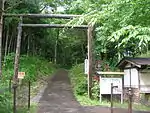 |
منابع
- «فهرست میراث جهانی یونسکو، اماکن تاریخی هیرائی زومی». دریافتشده در ۲۵-۰۹-۲۰۱۱. تاریخ وارد شده در
|تاریخ بازدید=را بررسی کنید (کمک) - Yiengpruksawan, Mimi Hall (1998). Hiraizumi: Buddhist Art and Regional Politics in Twelfth-Century Japan. Harvard University Press. ISBN 0-674-39205-1.
- Shiveley, Donald H.; McCullough, William H. (1999). Cambridge History of Japan II: Heian Japan. Cambridge University Press. p. 678. ISBN 0-521-22353-9.
- "Database of National Cultural Properties". Agency for Cultural Affairs. Retrieved 16 May ۲۰۱۱.
- Yiengpruksawan, Mimi Hall (1998). Hiraizumi: Buddhist Art and Regional Politics in Twelfth-Century Japan. Harvard University Press. pp. 67–۷۶, ۱۲۱–۱۴۲. ISBN 0-674-39205-1.
- Fukuyama, Toshio (1976). Heian Temples: Byodo-in and Chuson-ji. Weatherhill. ISBN 0-8348-1023-9.
- "Database of National Cultural Properties". Agency for Cultural Affairs. Retrieved 16 May ۲۰۱۱.
- "Database of National Cultural Properties". Agency for Cultural Affairs. Retrieved 16 May ۲۰۱۱.
- "Archaeologically Excavated Japanese Gardens Database". Nara Research Institute for Cultural Properties. Archived from the original on 22 August 2011. Retrieved 16 May 2011.
- Yiengpruksawan, Mimi Hall (1998). Hiraizumi: Buddhist Art and Regional Politics in Twelfth-Century Japan. انتشارات دانشگاه هاروارد. pp. 100–۱۰۵. ISBN 0-674-39205-1.
- "Kanjizaioin Temple Site". Mōtsū-ji. Archived from the original on 24 June 2011. Retrieved 16 May 2011.
- Yiengpruksawan, Mimi Hall (1998). Hiraizumi: Buddhist Art and Regional Politics in Twelfth-Century Japan. انتشارات دانشگاه هاروارد. pp. 106f. ISBN 0-674-39205-1.
- "Database of National Cultural Properties". Agency for Cultural Affairs. Retrieved 16 May ۲۰۱۱.
- "Muryokoin Temple Site". Mōtsū-ji. Archived from the original on 24 June 2011. Retrieved 16 May 2011.
- Yiengpruksawan, Mimi Hall (1998). Hiraizumi: Buddhist Art and Regional Politics in Twelfth-Century Japan. Harvard University Press. pp. 107–۱۱۱. ISBN 0-674-39205-1.
- "Database of National Cultural Properties". Agency for Cultural Affairs. Retrieved 16 May ۲۰۱۱.
- "Mt. Kinkei". Hiraizumi Tourism Association. Archived from the original on 14 July 2012. Retrieved 16 May 2011.
- Yiengpruksawan, Mimi Hall (1998). Hiraizumi: Buddhist Art and Regional Politics in Twelfth-Century Japan. Harvard University Press. p. 110. ISBN 0-674-39205-1.
| در ویکیانبار پروندههایی دربارهٔ اماکن تاریخی هیرائی زومی موجود است. |
This article is issued from Wikipedia. The text is licensed under Creative Commons - Attribution - Sharealike. Additional terms may apply for the media files.